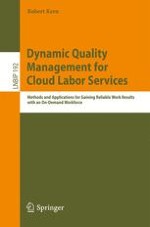How can a scalable and efficient quality management mechanism for cloud labor services be designed in a way that it delivers results with a well-defined level of quality to the requester?
Cloud labor services are a specific form of crowdsourcing: A coordination platform serves as an interface between requesters who need to get work done and a large crowd of workers who want to perform work. An early example of such a platform is Amazon’s Web marketplace Mturk, on which service requesters can publish open calls for so-called human intelligence tasks (HITs).
Robert Kern’s work makes a considerable contribution toward solving the quality problem for scalable human work. On the basis of a comprehensive framework of cloud labor, he develops a set of methods to conceptually measure and aggregate the quality of human work results, implements a platform to put those methods to work, and evaluates their application in a number of very compelling, real-world scenarios successfully combining concepts from statistics, information technology, and management. Reading this book will be beneficial to novices in cloud labor services looking for orientation in this new field as well as to advanced researchers and practitioners developing cloud quality concepts.
